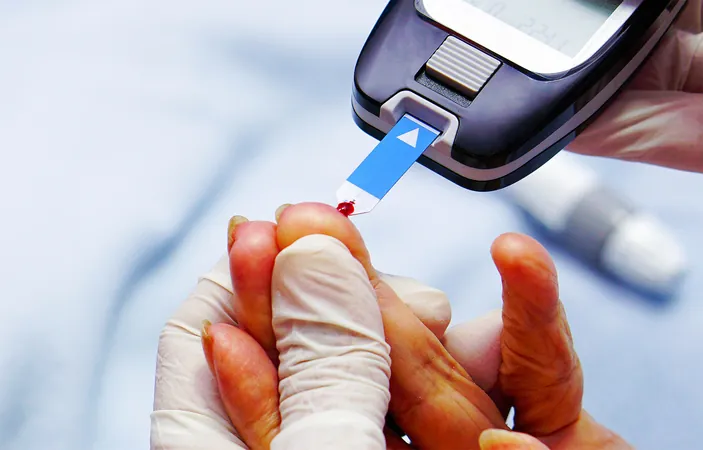
Type 5 Diabetes: A New Global Health Challenge Linked to Malnutrition
2025-07-04
Author: Yan
A New Era in Diabetes Recognition
The world of diabetes just got a significant upgrade! On April 9, 2025, the International Diabetes Federation (IDF) validated the existence of Type 5 diabetes, recognizing its connection to chronic malnutrition. This groundbreaking acknowledgment places malnutrition-related diabetes on the global health map.
Dr. Hawkins Speaks Out
Dr. Meredith Hawkins, an endocrinologist at the Albert Einstein College of Medicine and a key figure in the Global Diabetes Institute, highlighted the critical nature of this new diagnosis. Her insights reveal that Type 5 has been vastly underreported and misunderstood, leading to dire public health implications.
Why Type 5 Matters to You
With nearly 1 in 9 adults globally living with diabetes, and over 250 million unaware of their condition, Type 5's emergence demands attention. This new classification is particularly relevant for lean adolescents and young adults in Asia and Africa, where malnutrition is rampant and, alarmingly, comparable in scope to HIV infections.
A Paradigm Shift
Unlike Type 2 diabetes, which is often linked to over-nutrition, Type 5 surfaces in areas where food scarcity reigns. This shift in understanding reshapes the traditional narrative around diabetes, which has focused primarily on obesity.
Budgeting for Health Equity
Recognizing Type 5 is critical for public health funding. Under the banner of a new diabetes type, nations can allocate resources more effectively, ensuring those affected receive appropriate screening and treatment.
The Lasting Impact of Early Malnutrition
Research shows that a lack of proper nutrition during pregnancy and childhood can impede the development of insulin-producing pancreatic cells. Studies from South India reveal that adults with a body mass index (BMI) under 19 kg/m² experience uncontrolled blood sugar, tracing their origins back to in-utero malnutrition.
Connecting Nutrition and Diabetes Prevention
Community nutrition initiatives are not just about alleviating hunger; they can play a vital role in preventing diabetes in future generations. Investing in maternal nutrition is doubly impactful, breaking cycles of disease.
Unraveling the Metabolic Mystery
Recent studies indicate that Type 5 patients produce less insulin than their healthier counterparts despite being sensitive to insulin. This distinct metabolic fingerprint debunks assumptions and opens avenues for tailored treatments.
Navigating Treatment Challenges
Despite the evolving understanding of Type 5, many healthcare professionals remain uncertain about how best to treat these patients. Misdiagnosis could lead to dangerous repercussions, especially when mistaken for Type 1 diabetes.
A Call for Screening and Diagnosis Innovations
Healthcare providers are urged to adopt simple screening practices. For instance, a low BMI combined with a history of childhood malnutrition should prompt consideration of Type 5 diabetes.
Action Plans in Motion
Following the landmark vote in Bangkok, the IDF has launched a task force to develop diagnostic criteria and treatment plans aimed at improving patient outcomes by 2027. Early results could revolutionize diabetes care in low-income countries.
A Bright Future on the Horizon
Significant strides are being made toward addressing this emerging health threat. With advocates pushing for better nutrition policies and screening techniques, the goal is to halt Type 5 diabetes in its tracks—potentially paving the way for a healthier future for millions worldwide.
Conclusion
The recognition of Type 5 diabetes marks a pivotal moment in public health. Its implications extend far beyond individual diagnoses, touching on the broader issues of poverty, nutrition, and healthcare equity. It’s time to raise awareness and take action!



 Brasil (PT)
Brasil (PT)
 Canada (EN)
Canada (EN)
 Chile (ES)
Chile (ES)
 Česko (CS)
Česko (CS)
 대한민국 (KO)
대한민국 (KO)
 España (ES)
España (ES)
 France (FR)
France (FR)
 Hong Kong (EN)
Hong Kong (EN)
 Italia (IT)
Italia (IT)
 日本 (JA)
日本 (JA)
 Magyarország (HU)
Magyarország (HU)
 Norge (NO)
Norge (NO)
 Polska (PL)
Polska (PL)
 Schweiz (DE)
Schweiz (DE)
 Singapore (EN)
Singapore (EN)
 Sverige (SV)
Sverige (SV)
 Suomi (FI)
Suomi (FI)
 Türkiye (TR)
Türkiye (TR)
 الإمارات العربية المتحدة (AR)
الإمارات العربية المتحدة (AR)